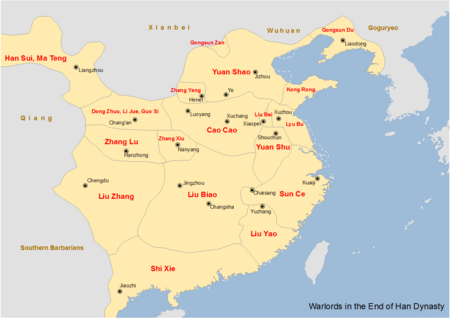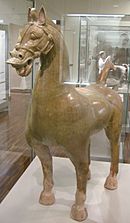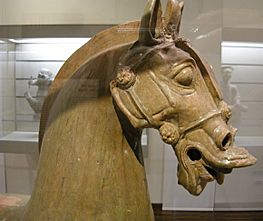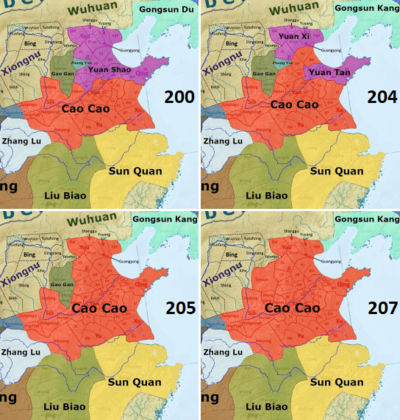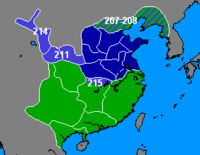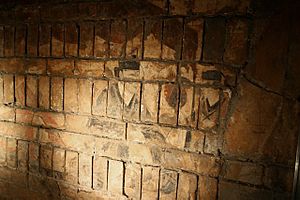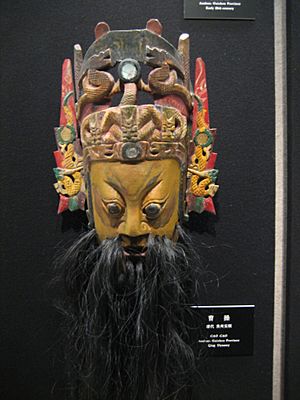Cao Cao facts for kids
Quick facts for kids Cao Cao曹操 |
|||||||||||||
|---|---|---|---|---|---|---|---|---|---|---|---|---|---|

A Ming dynasty illustration of Cao Cao in the Sancai Tuhui.
|
|||||||||||||
| King of Wei (魏王) | |||||||||||||
| Tenure | 29 May 216 – 15 March 220 | ||||||||||||
| Successor | Cao Pi | ||||||||||||
| Duke of Wei (魏公) | |||||||||||||
| Tenure | 16 June 213–216 | ||||||||||||
| Imperial Chancellor (丞相) | |||||||||||||
| Tenure | 9 July 208 – 15 March 220 | ||||||||||||
| Successor | Cao Pi | ||||||||||||
| Minister of Works (司空) | |||||||||||||
| Tenure | 196–208 | ||||||||||||
| Born | 155 Qiao County, Pei State, Han Empire |
||||||||||||
| Died | 15 March 220 (aged 64–65) Luoyang, Han Empire |
||||||||||||
| Burial | 11 April 220 Cao Cao Mausoleum |
||||||||||||
| Consorts | Consort Ding Empress Wuxuan Consort Liu Consort Huan Consort Du Consort Qin Consort Yin Lady Sun Lady Li Lady Zhou Lady Chen Lady Liu Lady Song Lady Zhao |
||||||||||||
| Issue | Cao Ang, Prince Min of Feng Cao Pi, Emperor Wen of Wei Cao Zhang, Prince Wei of Rencheng Cao Zhi, Prince Si of Chen Cao Chong, Prince Ai of Deng Cao Yu, Prince of Yan Empress Xianmu Princess Anyang Princess Jinxiang Princess Qinghe many other sons and daughters |
||||||||||||
|
|||||||||||||
| House | House of Cao | ||||||||||||
| Father | Cao Song | ||||||||||||
| Mother | Lady Ding | ||||||||||||
| Religion | Confucianism | ||||||||||||
| Occupation | Poet, statesman, warlord | ||||||||||||
| Military career | |||||||||||||
| Allegiance | Han Empire Guandong Coalition Wei |
||||||||||||
| Battles/wars | Yellow Turban Rebellion Campaign against Dong Zhuo Invasion of Xu Province Battle of Yan Province Campaign against Zhang Xiu Battle of Xiapi Campaign against Yuan Shu Battle of Guandu Battle of Bowang Battle of Liyang Battle of Ye Battle of Nanpi Battle of White Wolf Mountain Battle of Red Cliffs Battle of Tong Pass Battle of Xiaoyao Ford Hanzhong Campaign |
||||||||||||
| Cao Cao | |||||||||||||||||||||||||||||||||
|---|---|---|---|---|---|---|---|---|---|---|---|---|---|---|---|---|---|---|---|---|---|---|---|---|---|---|---|---|---|---|---|---|---|

Cao Cao's name in regular Chinese characters
|
|||||||||||||||||||||||||||||||||
| Chinese | 曹操 | ||||||||||||||||||||||||||||||||
|
|||||||||||||||||||||||||||||||||
Cao Cao (Chinese: 曹操; pinyin: Cáo Cāo) (born 155 – died 15 March 220) was a powerful Chinese leader, general, and poet. He was a top official in the Eastern Han dynasty and gained huge power as the dynasty was ending. Cao Cao helped create the state of Cao Wei, which was one of the three main states during the Three Kingdoms period. After he died, he was given the special title "Emperor Wu of Wei," even though he never called himself an emperor. Cao Cao is a famous historical figure. Some people see him as a cruel ruler, but others praise him as a brilliant leader, a military genius, and a great poet who cared for his soldiers.
During the fall of the Eastern Han dynasty, Cao Cao took control of most of northern China. This part of China was the most populated and developed at the time. As a top official, Cao Cao was very good at bringing back order and rebuilding the economy. However, he was criticized for controlling Emperor Xian, making the emperor a puppet ruler. This meant Cao Cao was truly in charge. Other warlords like Liu Bei and Sun Quan opposed him, and Cao Cao could not defeat them all.
Cao Cao was also very talented in poetry, calligraphy, and military strategy. He wrote many war journals, including notes on The Art of War by Sun Tzu.
Contents
- Early Life and First Steps
- Early Career and the Yellow Turban Rebellion (175–188)
- Alliance Against Dong Zhuo (189–191)
- Building His Territory (191–199)
- Uniting Northern China (200–207)
- Red Cliffs and Southern Campaigns (208–210)
- Campaigns in the Northwest (211–220)
- Death
- Cultural Legacy
- Mausoleum
- Family
- See also
Early Life and First Steps
Cao Cao was born in Qiao, Principality of Pei (which is now Bozhou, Anhui), in the year 155. His father, Cao Song, was the adopted son of Cao Teng. Cao Teng was a trusted official who served Emperor Huan. Some old records say that Cao Song's original family name was Xiahou, making him a relative of Xiahou Dun.
As a teenager, Cao Cao was known for being clever and a bit tricky. One story says his uncle complained to Cao Song about Cao Cao spending too much time hunting and playing music with Yuan Shao. To get back at his uncle, Cao Cao pretended to have a fit. His uncle quickly told Cao Song. But when Cao Song came to see him, Cao Cao was acting perfectly normal. He told his father, "I never had a fit. My uncle just doesn't like me, so he lied to you." After this, Cao Song stopped believing his brother about Cao Cao, and Cao Cao continued his wild ways even more openly.
There was a man named Xu Shao who was famous for judging people's talents. Cao Cao visited him, hoping for a good review that would help his career. At first, Xu Shao didn't want to say anything. But after Cao Cao kept asking, Xu Shao finally said, "You would be a good official in peaceful times, but a clever and sometimes ruthless hero in troubled times." Cao Cao just laughed and left.
Early Career and the Yellow Turban Rebellion (175–188)
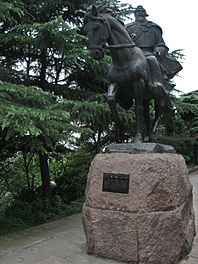
When he was 20, Cao Cao became a district captain in Luoyang. This was like being a police chief. He put up special stakes outside his office and ordered his officers to punish anyone who broke the law, no matter how important they were. Once, an uncle of Jian Shuo, a powerful official, was caught breaking the evening curfew. Cao Cao's men punished him. Because of this, Jian Shuo and other powerful people moved Cao Cao to a different job as governor of Qingfeng County. This moved him away from the capital.
Cao Cao stayed in this job for just over a year. He was then removed from office in 178 because of his distant family ties to the disgraced Empress Song. Around 180, Cao Cao returned to the court as a Consultant. He tried to fight against corruption and the influence of powerful officials, but he didn't have much success.
In 184, the Yellow Turban Rebellion began. This was a huge peasant uprising. Cao Cao was called back to Luoyang and made Captain of the Cavalry. He was sent to fight the rebels in Yingchuan. He succeeded in putting down the rebellion there. Then, he was sent to Jinan Commandery to stop the Yellow Turban influence from spreading. In Jinan, Cao Cao strongly enforced rules against unusual religious groups. He destroyed their shrines and supported the official state teachings of Confucianism. This upset the powerful local families. Fearing for his family's safety, he resigned in 187, saying he was sick. He was offered another job, but he refused and went home.
Alliance Against Dong Zhuo (189–191)
| Key Moments in Cao Cao's Life | |
|---|---|
| 155 | Born in Qiao. |
| 180s | Fought against the Yellow Turban Rebellion. |
| 190 | Joined the alliance against Dong Zhuo. |
| 196 | Welcomed Emperor Xian to Xu City. |
| 200 | Won the Battle of Guandu. |
| 208 | Lost the Battle of Red Cliffs. |
| 213 | Became Duke of Wei. |
| 216 | Became King of Wei. |
| 220 | Died in Luoyang. |
| — | Honored as Emperor Wu after his death. |
After 18 months away, Cao Cao returned to the capital Luoyang in 188. He was given a position in a new imperial army. However, this new army was quickly disbanded.
In 189, Emperor Ling died. His oldest son, Emperor Shao, took over, but powerful officials and the Empress Dowager controlled things. The Empress Dowager's brother, General He Jin, planned with Yuan Shao to get rid of a group of powerful officials known as the Ten Attendants. He Jin called Dong Zhuo, a skilled general, to bring his army to Luoyang. But before Dong Zhuo arrived, He Jin was killed. Luoyang fell into chaos as Yuan Shao's supporters fought the officials. Dong Zhuo's army easily took control of the palace. Dong Zhuo then removed Emperor Shao and put the young Emperor Xian on the throne, believing he would be easier to control.
Cao Cao refused an offer to work for Dong Zhuo. He left Luoyang and went to Chenliu, his hometown. There, he built his own army. The next year, regional leaders formed a military alliance against Dong Zhuo. Cao Cao joined them and was one of the few who actively fought. The warlords freed Luoyang, but Dong Zhuo's court escaped west to Chang'an, taking Emperor Xian with them. The alliance soon broke apart. China then fell into a civil war. Dong Zhuo was killed in 192 by Lü Bu.
Building His Territory (191–199)
Taking Control of Yan Province (191–195)
Cao Cao continued to grow his power through local wars. In 191, he became the Administrator of Dong commandery. He cleared the area of bandits. When the governor of Yan Province died, Cao Cao was asked to become the new governor. He had to deal with an uprising of Yellow Turbans who were raiding Yan. Despite some difficulties, Cao Cao managed to defeat the rebels by the end of 192. He added 30,000 of their troops to his own army. In 193, Cao Cao and Yuan Shao fought against Yuan Shao's cousin, Yuan Shu, driving him away.
In autumn 193, Cao Cao's father, Cao Song, was killed by soldiers of Tao Qian, the governor of Xu Province. Tao Qian said he was innocent and that the killers were rebellious soldiers. Cao Cao was furious. He led two attacks into Xu Province in 193 and 194, killing thousands of people to get revenge for his father. Because he took most of his soldiers to Xu Province, his own territory was left open.
Some unhappy officers, led by Chen Gong and Zhang Chao, planned a rebellion. They convinced Zhang Miao (Zhang Chao's brother) to lead them. They also asked Lü Bu to bring his soldiers to help. Chen Gong invited Lü Bu to be the new governor of Yan Province. Lü Bu agreed and brought his army. Since Cao Cao's army was away, many local commanders gave up and joined Lü Bu. However, three counties stayed loyal to Cao Cao. When Cao Cao returned, he gathered his forces there.
Throughout 194 and 195, Cao Cao and Lü Bu fought many battles for control of Yan Province. Lü Bu did well at first, holding the city of Puyang. But Cao Cao won almost every battle outside Puyang. Cao Cao's biggest victory happened near Dongming. Cao Cao was out with a small army, gathering food. When he saw Lü Bu and Chen Gong coming, he hid his soldiers in the woods and behind a dam. He sent a small group to fight Lü Bu's army. Once the fight started, he sent his hidden soldiers to attack. Lü Bu's army was badly beaten, and many soldiers ran away.
Lü Bu and Chen Gong both fled. Since Xu Province was now controlled by Liu Bei, who had been Cao Cao's enemy, they went to Xu for safety. Cao Cao decided not to chase them. Instead, he focused on defeating Lü Bu's supporters in Yan Province, taking full control of the area. Eighteen months after the rebellion started, Cao Cao had defeated Zhang Miao and his family, and by the end of 195, he had regained Yan Province.
Protecting the Emperor (196)
In early 196, Cao Cao moved his main base from Puyang to Xu City (today's Xuchang). There, he set up farms for soldiers and refugees to grow food. This helped feed his troops and the people.
Around August 196, Emperor Xian returned to Luoyang. Cao Cao joined the Emperor in autumn 196. He convinced the Emperor to move the capital to Xu City. His advisors, like Xun Yu, suggested this because Luoyang was destroyed by war. Cao Cao was made Minister of Works and given control over a large region. He also became General-in-Chief. Some people thought the Emperor was just a puppet under Cao Cao's control. But Cao Cao always followed a strict rule: he would not take the throne for himself. When his advisors suggested he start his own dynasty, he said, "If heaven wants me to have such a fate, let me be like King Wen of Zhou" (a respected ancient king).
To keep a good relationship with Yuan Shao, who was the most powerful warlord in China, Cao Cao tried to make Yuan Shao Minister of Works. But this backfired. Yuan Shao thought Cao Cao was trying to insult him because that title was lower than General-in-Chief. Yuan Shao refused the title. To calm him down, Cao Cao offered his own position to Yuan Shao and became Minister of Works himself. This solved the problem for a while, but it led to the big Battle of Guandu later on.
Fighting Zhang Xiu, Yuan Shu, and Lü Bu (197–198)
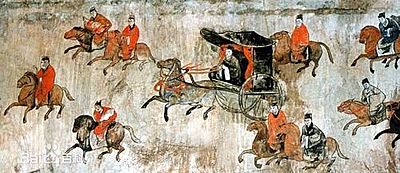
Liu Biao was a major power, controlling all of Jing Province. This area was rich, and many people had moved there to escape the wars in the north. So, Liu Biao was a threat to Cao Cao. Zhang Xiu controlled Liu Biao's land near Cao Cao's border. Cao Cao attacked him. In early 197, Zhang Xiu surrendered to Cao Cao. But later, Zhang Xiu attacked Cao Cao's camp at night (the Battle of Wancheng). Many people were killed, including Cao Cao's son Cao Ang. Cao Cao had to run away.
After a few months, Cao Cao focused on Yuan Shu, who had recently declared himself emperor. Cao Cao and other warlords formed an alliance against Yuan Shu. Cao Cao took all of Yuan Shu's lands north of the Huai River in autumn 197. Yuan Shu's remaining territory suffered from drought and bad harvests, making him weaker.
Later in 197, Cao Cao attacked Liu Biao and Zhang Xiu again. This time, Cao Cao was very successful and badly damaged their army. Cao Cao attacked Zhang Xiu again in 198, winning another victory. He eventually left this campaign because he heard Yuan Shao was planning to attack Xu. This report turned out to be wrong.
In April 198, Cao Cao encouraged warlords in the west to attack Chang'an, which was still controlled by Li Jue, Dong Zhuo's successor. One of Li Jue's officers rebelled and killed Li Jue and his family in summer 198. The officer sent Li Jue's head to Xu City, showing he would submit to Cao Cao.
Meanwhile, Lü Bu was becoming more aggressive. He drove Liu Bei (who had fled to Cao Cao) out of his territory again and joined forces with Yuan Shu. Since Zhang Xiu was no longer a threat in the south, Cao Cao went east to deal with Lü Bu.
Taking Xu and Yu Provinces (199)
Cao Cao defeated Lü Bu in many battles and finally surrounded him at Xiapi. Lü Bu tried to escape but couldn't. Many of his officers and soldiers left him and joined Cao Cao. Lü Bu lost hope and surrendered to Cao Cao, who had him executed on 7 February 199. By defeating Lü Bu, Cao Cao gained control of Xu Province.
With Lü Bu gone, Cao Cao dealt with Yuan Shu. He sent Liu Bei and Zhu Ling south to attack Yuan Shu. However, Yuan Shu died in summer 199 before they arrived. This meant Cao Cao no longer had major enemies in the Huai River region. Meanwhile, in March 199, Yuan Shao had finished his war with Gongsun Zan and was planning to move south to defeat Cao Cao. Seeing this, Cao Cao prepared his defenses, planning to make his stand at Guandu. Following advice, Zhang Xiu surrendered to Cao Cao, and his soldiers joined Cao Cao's army.
Uniting Northern China (200–207)
Liu Bei's Betrayal and Defeat
Near the end of 199, Liu Bei turned against Cao Cao. He killed Cao Cao's commanders in Xu Province and claimed the province for himself. Cao Cao wanted to attack Liu Bei quickly to avoid fighting on two fronts. Some at court worried that Yuan Shao would attack if the main army went east. But Guo Jia told Cao Cao that Yuan Shao would be slow to react. He said Cao Cao could defeat Liu Bei quickly. So, Cao Cao attacked Liu Bei and completely defeated him in Xu Province. He captured Guan Yu and Liu Bei's family in early 200. Liu Bei himself escaped to Yuan Shao, who only sent a small part of his army to attack Cao Cao. This attack was stopped in February 200, starting the open war between Cao Cao and Yuan Shao.
War with the Yuan Family
- The Guandu Campaign
In 200, Yuan Shao marched south towards Xu City, saying he wanted to rescue the emperor. He had over 110,000 soldiers, including 10,000 heavy cavalry. Cao Cao had about 40,000 men, most of whom he gathered at Guandu. This was a key location on the Yellow River. Cao Cao's army repeatedly pushed back Yuan Shao's attacks and won smaller battles. The two armies then faced each other at Guandu for months. Neither side could make much progress. Cao Cao had fewer men, so he couldn't attack much. Yuan Shao was too proud to use his large army wisely.
Despite having many more soldiers, Yuan Shao couldn't use his strength well because he was unsure and Cao Cao had a strong position. While the main battle was at Guandu, there were also fights on the eastern and western sides. On the eastern side, Yuan Shao's son, Yuan Tan, fought against Zang Ba of Cao Cao's army. Cao Cao's side won easily because Zang Ba knew the land well and used quick attacks. On the western side, Yuan Shao's nephew, Gao Gan, did better against Cao Cao's army. He forced Cao Cao to send more soldiers there.
Liu Bei, who was staying with Yuan Shao, suggested starting a rebellion in Cao Cao's lands. This plan worked at first. But Man Chong's good diplomacy quickly solved the problem. Cao Cao had placed Man Chong there because he expected such a rebellion. A raid by Cao Cao destroyed Yuan Shao's supply base, forcing Yuan Shao to set up a new one. Finally, a soldier from Yuan Shao's army, Xu You, told Cao Cao where the new supply base was. Cao Cao broke the stalemate by sending a special group of soldiers to burn all of Yuan Shao's supplies. This greatly lowered Yuan Shao's soldiers' spirits. Yuan Shao made one last, costly attack on Guandu, which failed. The next morning, Cao Cao launched a surprise attack on the retreating enemy army, winning a huge and unexpected victory. Cao Cao reported to Emperor Xian that he had killed over 70,000 of Yuan Shao's soldiers. He later ordered most captured enemy soldiers to be buried alive. A few months later, in May or June 201, Cao Cao defeated Yuan Shao again, destroying Yuan Shao's last forces south of the Yellow River.
- Taking Control of the North
Yuan Shao became sick after the defeat and died in June 202. He left three sons but no clear successor. He seemed to prefer his youngest son, Yuan Shang. But his oldest son, Yuan Tan, challenged him. The two brothers started fighting each other, even while fighting Cao Cao. Cao Cao used this family conflict to his advantage. During the Battle of Liyang (October 202 – June 203), he pushed the Yuan brothers back to their stronghold. He then pulled back, focusing on keeping the land he had gained. This might have been because he needed to deal with problems at the imperial court.
With less pressure from Cao Cao, the brothers' fight grew worse. Yuan Shang attacked Yuan Tan's base, forcing Yuan Tan to make a deal with Cao Cao. Cao Cao took control of Ji Province in summer 204 after a five-month siege. Cao Cao visited Yuan Shao's tomb after taking the city. He cried for his old friend and gave gifts and money to Yuan Shao's family. Yuan Shang fled north, and Gao Gan, another governor, joined Cao Cao. In 205, Cao Cao defeated and killed Yuan Tan, taking Qing Province. Gao Gan rebelled in 205, but Cao Cao defeated and killed him in 206, taking Bing Province as well.
Cao Cao now ruled all of northern China. Yuan Shang and Yuan Xi, another son, fled to the Wuhuan chieftains for help. The Wuhuan leader, Tadun, helped the Yuan brothers and started raiding Cao Cao's land. In 207, Cao Cao led a bold campaign beyond China's borders to finally destroy the Yuan family. He fought the Wuhuan chieftains in the Battle of White Wolf Mountain. Even though he was outnumbered and far from home, Cao Cao won. He did this by cleverly managing his supplies and attacking the enemy from the side. He killed Tadun and forced the Yuan brothers to flee again. This time, they went to Gongsun Kang for help. But Gongsun Kang executed them and sent their heads to Cao Cao. This gave Cao Cao control over You Province. The northern tribes were now afraid of Cao Cao. Most of the remaining Wuhuan, along with the Xianbei and Xiongnu, surrendered to him.
Red Cliffs and Southern Campaigns (208–210)
Taking Jing Province (208)
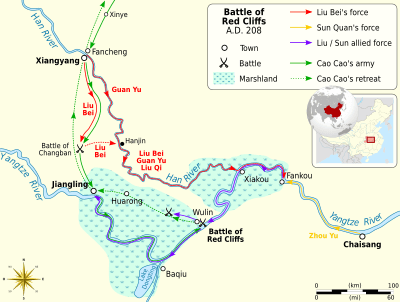
After Yuan Shao's defeat in 200, Cao Cao forced Liu Bei to flee to the governor of Jing Province, Liu Biao. Liu Biao placed Liu Bei on the northern border to keep Cao Cao away. An early attack by Cao Cao on Liu Bei was stopped in 202. After conquering northern China in 207, Cao Cao focused on Jing Province. A dispute over who would rule Jing Province started after Liu Biao died in August 208. Liu Biao had chosen his younger son, Liu Cong, but his older son, Liu Qi, challenged him. Meanwhile, Sun Quan attacked the eastern parts of Jing, and Liu Bei hoped to take Jing for himself.
Cao Cao quickly invaded Jing from the north in September. Liu Cong surrendered to him without a fight. Liu Bei fled south, but he was slowed down by many refugees following him. Cao Cao's 5,000 elite cavalry caught up with Liu Bei and completely defeated him in October. They captured Liu Bei's supplies and the refugees. Liu Bei barely escaped east with a few friends. He met up with Liu Qi and sent Zhuge Liang to make an alliance with Sun Quan. Sun Quan agreed to join forces. Cao Cao gained control of a large part of the Yangtze River by taking the naval base. He ordered most of his army to sail down the river towards Chibi (Red Cliffs), while the rest marched by land. He planned to defeat the new alliance quickly.
Battle of Red Cliffs
At the Battle of Red Cliffs in the winter of 208, Cao Cao's forces were defeated by the alliance of Liu Bei and Sun Quan. Sun Quan and Liu Bei later founded the states of Eastern Wu and Shu Han, becoming Cao Cao's main rivals. Even though Cao Cao had more soldiers, his northern troops were tired from marching. They were also getting sick in the unfamiliar southern climate and felt seasick on the river boats. To try and stop the seasickness, they chained their ships together. Sun Quan's soldiers, however, were fresh and experienced in river fighting.
The allied general Huang Gai pretended to surrender to Cao Cao. But he used the fact that Cao Cao's ships were chained together to destroy them with fire ships. At the same time, an allied attack led by Zhou Yu defeated Cao Cao's land forces.
Throughout 209 and 210, Cao Cao's commanders defended against Sun Quan. In battles, Cao Cao's commanders in northern Jing fought against Sun Quan. They had mixed success, and Cao Cao kept some land in the north of that province. They also stopped an attack and put down a rebellion, preventing Sun Quan from moving further. However, Cao Cao's commanders in southern Jing, cut off from the rest of his forces, surrendered to Liu Bei. Liu Qi became governor of Jing Province after his father, but he died in 209. After that, Sun Quan made Liu Bei governor of Jing Province and married his sister, Lady Sun, to him to strengthen their alliance.
Campaigns in the Northwest (211–220)
By 211, the situation in the south was stable. Cao Cao decided to defeat his remaining enemies in the northwest, west of Chang'an. In Hanzhong, Zhang Lu was leading a rebellion against the Han dynasty, running his own religious state. Cao Cao sent an army to force Zhang Lu to surrender. However, this worried several warlords in the Wei River valley. They united under Han Sui and Ma Chao to fight Cao Cao. They believed Cao Cao's actions against Zhang Lu were actually aimed at them.
Cao Cao personally led his army against this alliance. He outsmarted the rebel army at every turn in the Battle of Tong Pass. The alliance broke apart, and many of their leaders were killed. Cao Cao spent the next month or two hunting down some of the leaders, many of whom surrendered to him. He left the region in 212, leaving Xiahou Yuan to finish taking control of the northwest.
In 213, Cao Cao was given the title "Duke of Wei." He received special honors and control over ten cities, known as Wei. That same year, he marched south and attacked Ruxu. Sun Quan's general, Lü Meng, held off the attacks for about a month. Cao Cao had to retreat, confirming Sun Quan's control of the southeast. In 215, Cao Cao moved into and took over Hanzhong. However, Liu Bei later took the region from him a few years later. In 216, Cao Cao was promoted to "King of Wei." Over the years, Cao Cao, Liu Bei, and Sun Quan continued to strengthen their power in their own regions. Through many wars, China became divided into three powers: Wei, Shu, and Wu. They fought battles without any side gaining a clear advantage. The only big change was when Liu Bei's forces took Hanzhong from Cao Cao's army after a two-year campaign.
Death
On 15 March 220, Cao Cao died in Luoyang at the age of 65. He had not managed to unite all of China under his rule. He reportedly died of a "head disease." In his will, he asked to be buried simply near another tomb, without gold or jade treasures. He also asked that his soldiers on the frontier stay at their posts and not attend his funeral. He said this was because "the country is still unstable."
Cao Cao's oldest surviving son, Cao Pi, took over after him. Within a year, Cao Pi forced Emperor Xian to give up his throne. Cao Pi then declared himself the first emperor of the state of Cao Wei. Cao Cao was then given the special title "Grand Ancestor Emperor Wu of Wei" after his death.
Cultural Legacy
While historical records show Cao Cao as a brilliant ruler, he is often shown as a cunning and dishonest man in Chinese opera. In opera, his character wears white face paint to show his tricky personality. When Luo Guanzhong wrote the historical novel Romance of the Three Kingdoms, he was inspired by Chinese opera.
Because of this, the image of Cao Cao as a ruthless villain became more popular than his true historical image. There have been efforts to change this view.
As the novel Romance of the Three Kingdoms has been made into modern movies and games, Cao Cao continues to be shown as a main villain.
Even today, the Chinese saying for "speak of the Devil" is "speak of Cao Cao and Cao Cao arrives" (simplified Chinese: 说曹操,曹操到; traditional Chinese: 說曹操,曹操到; pinyin: shuō Cáo Cāo, Cáo Cāo dào).
In Romance of the Three Kingdoms
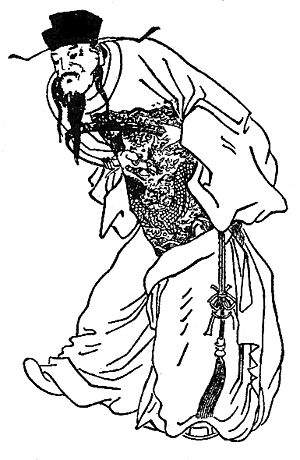
Romance of the Three Kingdoms is a historical novel written by Luo Guanzhong in the 14th century. It tells a romanticized version of events from the late Han dynasty and the Three Kingdoms period. While it mostly follows historical facts, the novel changed Cao Cao's character to make him seem like a cruel and suspicious villain. In some parts, the author made up or partly made up stories about Cao Cao.
Some made-up stories about Cao Cao in Romance of the Three Kingdoms include:
- List of fictitious stories in Romance of the Three Kingdoms § Cao Cao presents a precious sword
- List of fictitious stories in Romance of the Three Kingdoms § Cao Cao arrested and released by Chen Gong
- Lü Boshe
- List of fictitious stories in Romance of the Three Kingdoms § Guan Yu releases Cao Cao at Huarong Trail
- List of fictitious stories in Romance of the Three Kingdoms § New Book of Mengde
- Battle of Tong Pass (211) § In fiction
- List of fictitious stories in Romance of the Three Kingdoms § Cao Cao's death
Farming and Education
While fighting his military campaigns, Cao Cao also paid attention to farming and education, which were important for society.
In 194, a locust plague caused a terrible famine across China. Without food, many armies were defeated without even fighting. From this, Cao Cao learned how important a good food supply was for a strong army. He started farming programs in cities like Xu City. Refugees were hired and given empty land to farm. Later, army camps that were not in immediate danger of war were also made to farm. This system continued and spread as Cao Cao's territory grew. While Cao Cao's main goal was to build a strong army, his farming program also improved the lives of the people, especially war refugees.
By 203, Cao Cao had defeated most of Yuan Shao's forces. This allowed him to focus more on building up his own land. In the autumn of that year, Cao Cao ordered that education should be promoted in all counties and cities under his rule. An official in charge of education was assigned to each county with more than 500 families. Young people with talent were chosen for schooling. This helped make sure that smart people were still being trained during those years of war. Cao Cao said this would benefit the people.
Poetry
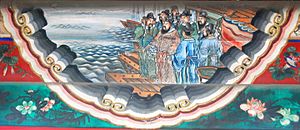
Cao Cao was a skilled poet, just like his sons Cao Pi and Cao Zhi. He also supported other poets. Only some of Cao Cao's poems remain today. His simple yet deep verses helped change the style of poetry at his time and later. They contributed to the poetry styles of the Tang dynasty. Cao Cao, Cao Pi, and Cao Zhi are known together as the "Three Caos." Their poetry, along with other poets, became known as the "Jian'an" style. Cao Cao also wrote poems in an older style with four characters per line.
Mausoleum
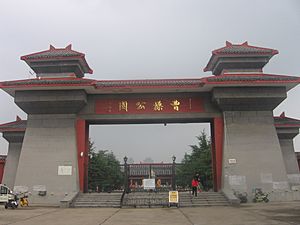
On 27 December 2009, officials announced the discovery of Cao Cao's tomb in Xigaoxue Village, Anyang County, Henan. The tomb, which covers an area of 740 square meters, was found in December 2008. Workers at a nearby kiln were digging for mud when they found it. Its discovery was not reported until local authorities seized a stone tablet from grave robbers. The tablet had the words 'King Wu of Wei'—Cao Cao's title after his death. The robbers claimed they stole it from the tomb. Over the next year, archaeologists found more than 250 items in the tomb. The remains of three people—a man in his 60s, a woman in her 50s, and another woman in her 20s—were also found. People believe these are the remains of Cao Cao, one of his wives, and a servant.
Since the tomb was found, many experts have questioned if it is truly Cao Cao's. In January 2010, the government officially said that the tomb was likely Cao Cao's. However, in August 2010, 23 experts said that the findings and items from the tomb might be fake. In September 2010, an article in an archaeology magazine claimed that the tomb actually belonged to Cao Huan (Cao Cao's grandson) and his father Cao Yu.
In 2010, the tomb became a protected historical site in China. As of 2011, the local government in Anyang announced they are building a museum at the tomb site. It will be called 'Cao Cao Mausoleum Museum'.
News reports from 2018 describe the tomb complex. It has an outer foundation made of packed earth, a special path, and structures on the east and south sides. Archaeologists also noticed that the tomb's outside and edges were left unmarked on purpose. There are no buildings above ground around the tomb, nor large piles of dirt nearby. This matches old records that say Cao Pi ordered monuments to be taken down. This was to honor his father's wish to be buried simply and secretly, and to stop tomb robbers from finding it.
Family
Cao Cao had many wives and children. Here are some of his family members:
- His main wife was Lady Ding.
- His second main wife was Empress Wuxuan.
- Their sons included Cao Pi (who became Emperor Wen), Cao Zhang, Cao Zhi, and Cao Xiong.
- They also had a daughter, Empress Xianmu, who married Emperor Xian.
- With Lady Liu, he had Cao Ang and Cao Shuo. He also had Princess Qinghe.
- With Lady Huan, he had Cao Chong, Cao Ju, and Cao Yu.
- With Lady Du, he had Cao Lin and Cao Gun. He also had Princess Jinxiang.
- He had many other sons and daughters with other wives and consorts.
See also
 In Spanish: Cao Cao para niños
In Spanish: Cao Cao para niños
- Cao Wei family trees
- Lists of people of the Three Kingdoms
- Bronze Bird Terrace
- Empty Fort Strategy


